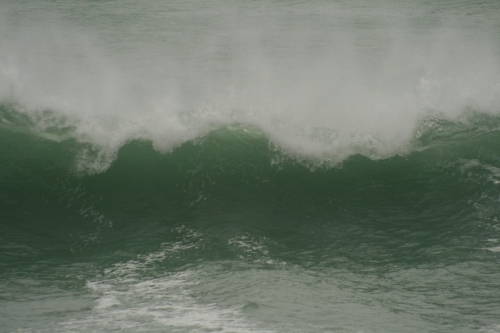Fetch
Fetch is an important factor in the formation, size and power of waves. Despite its importance fetch is a very simple thing. In the most straightforward way, fetch is just the maximum length of open water over which the wind can blow.
Almost all of us have noticed that when the wind blows over a calm pond or lake we will see ripples on the water's surface betraying where the wind is at work. The work being done by the wind is actually called frictional drag, and is a transfer of energy from the wind to the water. Just as you see ripples on a drink or a bowl of soup when you blow on it, the wind creates ripples on the surface of the sea when it blows over that.
Generally,(ignoring dead calm and very, very silly high speeds), the amount of energy transferred from the wind to the water will increase according to the length of time the wind is able to blow over it. More energy will be transferred if the wind can blow over the water for a long time than will be transferred if the wind can only blow over it for a shorter time. The force of the wind is also a factor in determining the size and nature of waves. You can read more about the types of sea produced by different wind speeds on the Beaufort Scale page.
So, what determines how long the wind can blow, uninterrupted, over a body of water? The answer is very simple - it's the length of the water between one obstacle and the next one. That length of open water over which the wind can blow unobstructed is called the Fetch. For a bowl of soup it would be one edge of the bowl to the other, for a lake it's one shore to the opposite one, and for a sea or ocean it's exactly the same idea, but obviously with greater distances.
A very short fetch, like the soup bowl or the width of a small lake just isn't long enough for the amount of energy needed to make big waves to be transferred to the water. You don't get 10m high waves on a 50m wide lake, regardless of how deep it may be! Where you have a much larger lake, such as the North American Great Lakes, the large African lakes, and various inland seas, the much longer fetch allows larger and more powerful waves to be created.
 |
In the United Kingdom, the south western coast (for example,Lands End in Cornwall) is exposed to the Atlantic Ocean, with some waves potentially originating just off the South American coast. The opposite end of the southern coast, the south eastern coast (around Dover in Kent) is exposed to a sea with a fetch that is a mere 40km or so from the northern coast of France. Consequently, the energy and power of the waves hitting the south western coast are likely to be much higher than are experienced along the south eastern coast. The wave photographed here was approaching cliffs on the north Cornish coast and was about 3m high. |
It is very important to remember that fetch is the maximum length of open water over which the wind can blow unobstructed. Waves with the highest energy levels will result from a combination of a long fetch and a consistent dominant wind blowing in the same direction. So, in simple terms, the bigger the fetch, the bigger the wave.
Although there is a fetch of thousands of km between South America and the coast of Cornwall, unless the wind is blowing from the same direction as South America and along the entire length of the fetch, the resulting waves will not have been created at the far end of the fetch. They may have formed only a short distance away if the wind has been blowing erratically or from a different direction.
![]()
